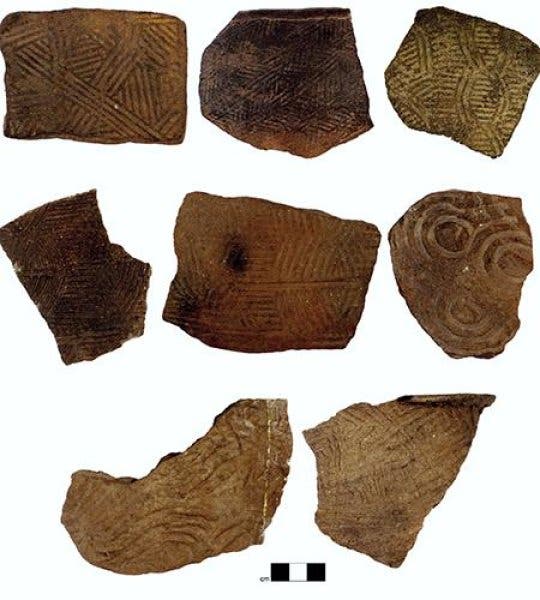Societies in America’s southern Appalachian mountains shared art and technologies through regional networks reminiscent of today’s social media, a new study reports.

Image credits Jacob Lulewicz, (2019), PNAS.
Native American villages established social and political connections well before European explorers came a-knocking, new research reveals. These systems — which functioned similarly to today’s platforms such as MySpace or Facebook, the author notes — laid the groundwork for local political systems as far back as 600 A.D.
Like, subscribe, and comment!
“Just as we have our own networks of ‘friends’ and ‘followers’ on platforms like Facebook and Twitter, societies that existed in North America between 1,200 and 350 years ago had their own information sharing networks,” said Jacob Lulewicz, the study’s author and a lecturer of archaeology in the Department of Anthropology in Arts & Sciences.
“Our study found a way to reconstruct these indigenous communication networks.”
The study used social network analysis techniques to map out the social and political relationships established between dozens of Native American villages in the studied region. The data came from messages embedded not in bytes, but in bits of pottery unearthed at sites throughout southern Appalachia clustered around the site of Etowah in Bartow County, Georgia (belonging to the so-called Mississippian culture). This included 276,626 sherds from 43 sites across eastern Tennessee and 88,705 sherds from 41 sites across northern Georgia. All the pottery dates between 800 and 1650 A.D., a period that saw the gradual emergence and subsequent decline of powerful chiefdoms that controlled wide networks of villages in the region.
Each fragment of pottery was analyzed to help Lulewicz understand how the technology used to make pottery and the symbols used to decorate them evolved over time. Armed with this rough timeline, Lulewicz then looked at how both elements disseminated among different villages or communities over time — in broad lines, this gave him a rough indication of how intensely they communicated.
Etowah served as the regional seat of social, political, economic and religious power across the region. This influence reached its peak between 1050 to 1325 A.D. and was still running in 1540 A.D. when the Spanish explorer Hernando de Soto first reached this area. De Soto accounts how the villages in this area were loosely bound to the influence of a single chief who resided in the town of Coosa (northern Georgia)
Lulewicz argues — based on his findings — that these political elites could emerge because of the social networks he describes. Their political power and centralized leadership, as well as the religious movements and inequality associated with their rule, were built on top of these wider, pre-existing social networks of common people. And, in the end, these networks would prove to be more stable and durable than any interactions dictated by elite chiefs.
“What I show in the paper is that while we see things like the emergence of super powerful chiefs and the rise of major economic inequalities, the very foundations of society — especially relationships and networks of kinship and family and reciprocity — remained virtually unchanged over 1,000 years,” Lulewicz said.
“That is, even though elite interests and political strategies waxed and waned and collapsed and flourished, very basic relationships and networks were some of the strongest, most durable aspects of society.”
Lulewicz argues that these findings show how important social connections between individuals are in guarding communities against unpredictable (or incompetent) leaders and the extended ruling class. He says it mirrors how digital social networks function today, and their role in contemporary revolutions or protest movements. Modern states are often quick to monitor, censor, or even shut down access to these virtual networks, he adds, which shows how valuable such social instruments are even today.
“This is super interesting — at least to me as a social scientist — for understanding how political movements actually play out,” he said. “It doesn’t come down to any particular, innate attribute of leaders and elites. What is comes down to is how those individuals are able to leverage the networks in which they are embedded.”
“Even though chiefs emerge at about 1000 A.D., over the next 650 years, chiefs actually shift their strategies of political and economic control. They tap into different parts of their networks, or leverage their connections in very different ways throughout time.”
“Because these very basic networks were so durable, they allowed these societies — especially common people — to buffer against and mediate the uncertainties associated with major political and economic change. They may have said, ‘You go live on top of that huge mound and do your sacred rituals, and we will go about life as usual for the most part.’ These communication networks served as a social constant for these people and allowed their cultures to persist for thousands of years even across transformations that could have been catastrophic.”
The paper “The social networks and structural variation of Mississippian sociopolitics in the southeastern United States” has been published in the journal PNAS.



